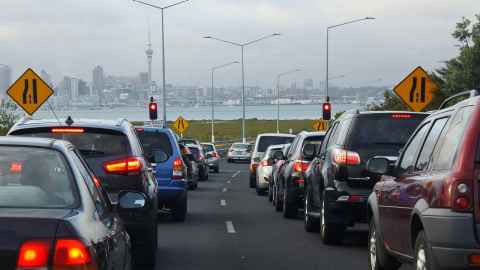Axing the Auckland fuel tax reveals the lack of a real transport plan
16 February 2024
Opinion: By moving to scrap the fuel tax, the government continues a decades-long pattern of transport policy U-turns, writes Timothy Welch.

The government’s recent announcement that it would bring forward legislation to end the Auckland Regional Fuel Tax (ARFT) in June – four years early – is the third time in 30 years a National-led government has repealed such a tax.
Pulling the plug seems less about the cost of living or misuse of tax revenue than simply sweeping clear the previous administration’s legislation. Transport policies, plans and projects have fallen at an astonishing speed since the coalition government was formed.
One of its first acts was to cancel the clean car discount that helped create a market for electric vehicles by subsidising their cost. Unsurprisingly, sales of EVs took a plunge in January. At the same time, a higher registration fee for “high-emitting vehicles”, dubbed the “ute tax”, was abandoned.
As the new government took office, transport agency Waka Kotahi quickly announced a freeze on cycling, walking and public transport projects. Road projects seem unaffected.
Other car-centric policies include plans to roll back hard-won speed limit reductions, cancel light rail projects in Wellington and Auckland, and nix a second multimodal Auckland harbour crossing.
Transport minister Simeon Brown recently doubled down on this when he announced that any additional harbour crossing would be for the exclusive use of vehicles – directly excluding consideration of cycling, walking and rail.
Missing in all this is a clear vision of what will replace all the lost policies.
"Decades of see-sawing government priorities mean New Zealand’s biggest and most economically important city has no clear plan to transition out of its fossil fuel dependence."
Cost of living or climate
The now defunct regional fuel tax was put in place by the Labour government in 2018. It was meant to last ten years and raise NZ$1.5 billion to help fund a list of projects: the Eastern Busway, new electric train units for the City Rail Link, improved bus links to the airport, and redevelopment of the downtown ferry terminal.
The tax also funded road safety initiatives, road corridor improvements, bus and cycle lanes, red light cameras and speed humps. These were all clearly listed in the fuel tax legislation – and are clearly needed: Auckland road deaths hover around 50 people per year.
The government has also announced that legislation to axe the ARFT would specifically ban spending any remaining funds (estimated to be over $380 million) on cycle or bus lanes. This is despite strong arguments in favour of sustainable travel modes, as global temperatures surpassed the critical 1.5 degrees Celsius threshold last year.
Instead, the official rationalisation for ending the ARFT has centred on the cost of living. For instance, Simeon Brown has argued drivers with a Toyota Hilux could save “around $9.20 every time they fill up”.
Based on the Hilux’s 80-litre fuel tank and an average 12,000 kilometres per year travelled, that equates to about $92 per year, or $1.77 per week. The savings shrink significantly for smaller, more efficient vehicles.
Meanwhile, the government has announced plans to enact a road user charge for battery electric and plug-in hybrid vehicles. On top of removing the clean car discount, this makes low-emitting vehicles less competitive on price.
Failure to plan
Shifts in funding priorities are part of politics, of course. But the latest U-turns bring into sharp focus a lack of direction on infrastructure. This includes previous governments, National and Labour alike, which have failed to lock in sustainable forward planning.
Nothing exemplifies this more than the on-again, off-again plans for an expanded or new Auckland harbour crossing. After several false starts under the previous Labour government, the new government again cancelled the plans in favour of “providing extra lanes for traffic” and “enhancing the existing busway”.
This is despite 70 years of evidence showing that adding more roads worsens congestion. As the adage goes, failing to plan is planning to fail.
Consequently, New Zealand’s vehicle ownership rates are among the highest in the world. Per-capita road deaths are higher than in many peer nations. At the same time, rates of walking, cycling and public transport use remain stubbornly low – due mainly to a lack of supply, rather than insufficient demand.
Nationally, rail networks remain under-developed, despite clear demand and excellent examples of success internationally.
Decades of see-sawing government priorities mean New Zealand’s biggest and most economically important city has no clear plan to transition out of its fossil fuel dependence.
Unless long-term transport planning and related infrastructure projects are elevated out of the political cycle, it is hard to be optimistic about sustainable progress.
Dr Timothy Welch is a senior lecturer in Urban Planning in the Faculty of Creative Arts and Industries.
This article reflects the opinion of the author and not necessarily the views of Waipapa Taumata Rau, University of Auckland. It was first published in The Conversation.
Media contact
Hussein Moses | Media adviser
M: 027 361 1000
E: hussein.moses@auckland.ac.nz